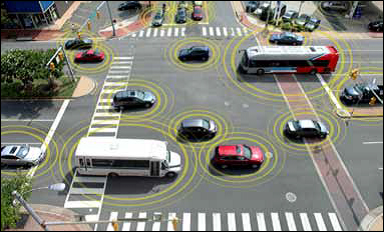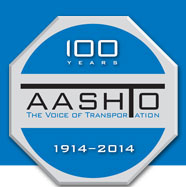
September 19, 2013
Transportation Initiatives: Then and Now

The following is a piece published in the Summer 1997 edition of the AASHTO Quarterly discussing smart vehicle, and, on a lesser scale, connected vehicle technologies. The article highlights what technology can do for roadway safety, which is the reason transportation experts still push the issue today. Check out the story below, originally drafted by Dr. Robert Maki.
Now it's your turn. You are boarding a specifically-equipped bus produced through the combined efforts of Carnegie Mellon University and the Metropolitan Transit Authority of Harris County (Houston Metro). Called a "free agent," the bus will demonstrate vehicle-based AHS technologies which have the advantage of operating on real-life roadways with no special highway modifications. So sit back and take a ride along Interstate 15 in San Diego with your guide, Chuck Thorpe of Carnegie Mellon University.
We don't need to have our vehicles running at a specifically prepared lane or anything. We take our vehicles and put them out on the regular roadways—no modifications to the infrastructure, no bearing magnets or anything like that. We put them out in mixed traffic with other manually driven vehicles. Because we have sensors all the way around the vehicle, we have basically eyes in the back of our heads. We can see what other traffic is doing. We can see what the road is doing. We can react to other traffic. We can be safe drivers and we can be courteous drivers even when it's just the automated vehicle out on the lane. We call them "free agents" because they are smart enough to run themselves.
They are also smart enough that if they do see another automated vehicle, they will communicate with it on a digital radio and they can close up the gap. They can trust the other vehicle to tell them what's going on around them. If there is a traffic management center in the area, they are smart enough to listen to it and take advice—like "there is stopped traffic around the corner" or "you are coming out of the 65 mph limit zone into a 55 mph zone," and they can listen to other advisories if there are any. They don't have to listen to those advisories that aren't applicable.
Why is this important? First of all, it probably makes sense to put AHS in a place like downtown Los Angeles and have a dedicated lane that only has computer controlled vehicles running on it. That way, all the vehicles are talking to each other; they are talking to the infrastructure. You could really pack of a lot of vehicles in there and get the ultimate in safety and capacity.
Check on the next problem—nobody is going to out and buy an AHS vehicle if there is no lane to run it on, and no one is going to go out and build the lanes until there are vehicles that will run on them. A free agent system like this one with the sensors all around could be used from day one. The whole idea is to introduce these vehicles gradually into the traffic flow. It won't really improve thru-put very much because you still have to keep the same distances for all those whacko human drivers out there. But eventually, as you get more and more of these vehicles out there and they start talking to each other, they will close up the gaps and eventually have a dedicated lane all to themselves.
The second reason we like these free agents is for rural applications. Think about running on I-80 across the country. It only has two lanes each direction most of the way. You couldn't take away one of those lanes and make it just for the computer-controlled vehicle. That would make the manual drivers in the other lanes pretty unhappy. So, for applications like long-haul trucking, it really makes sense to put all the sensors on the vehicle and put them out there in mixed traffic.
The last reason why we like the free agent is for safety applications. About 90 percent of all accidents are caused, at least in part, by human error. A large part of what we are trying to do in this program is to eliminate those human error caused accidents. Most of those accidents aren't taking place on the Interstates. If you have a free agent vehicle, it's got the sensors all around the vehicle so you can use those sensors even when you are not on the Interstate—even when you're not driving autonomously—to help you drive. The same vision system which is watching the road and steering the vehicle when you're under automated control can also be watching how you're driving. And, if the road is curving left and you're curving right, the system will say, "this guy's going off the road." If you haven't put on your turn signals, it will say, "I bet this person isn't leaving the road on purpose, maybe they've fallen asleep," and it can beep at you. It can shake the steering wheel trying to wake you back up, give you an extra couple seconds of alert to get you back on the road to keep you from wrapping yourself around a telephone pole.
Same thing with the radar looking forward. If you're coming up too close behind somebody, it'll warn you, tap on the brake pedal, beep at you, to warn you and try to prevent you from having a rear-end collision. Same thing with the side-looking sensors. If you're trying to change lanes and there is someone in your blind spot, the sensor will see it and warn you.
It really is trying to improve safety with fully-automated driving, partially automated driving, and completely off the automated system when you're driving yourself.
What multi-platform means is that in our scenarios we have two cars, one minivan, and two Houston Metro buses. We developed all this technology on the cars and that's nice, but we were really excited when the Houston Metro Bus Company came along and said, "We want this stuff on the buses." See, what we're up to in automated highways is really to try to improve transportation for everyone. It's nice to show that we can make the cars more efficient and safer and so forth, but it's also important to the people who ride buses every day on their commute, to show that we can make the buses safer. We can pass them more close to each other so we can get more buses on the crowded bus lanes.
We also have a technology to work on truck safety. We are really trying to improve the transportation system across the board.
Okay, that's a little bit about sort of the social background of why we built this system. Let me tell you a little bit about what I consider the cool engineering details.
The video camera is connected to a PC—a standard PC—in fact the PC we have in the trunks of the cars is not as powerful as the one I have sitting on my desk. In the PC there is a program running called "Ralph." Ralph is looking out there at the road and trying to decide how to steer. So Ralph will look for the painted lines (where there are lines); it'll try to fin the solid lines and say "that's a road edge border—don't cross that; try to find the dashed line of paint, stop" and say "That's a lane boundary, you can cross that." But it is also looking at all the things that you and I would look at. It's looking for the edge of the shoulder, it's looking for the pavement joints—all the long linear high contrast features running down along the road.
It's using all of those to figure out, not only where the vehicle is left/right in the road, but how the road is curving up ahead. The radar we have running on the buses is a commercially available radar. That's nice because we can just go out and buy it, but that's just the spot radar. It tells us if there is something in front of us or not. The radar we have on the cars is an experimental radar from Delco. It scans back and forth, so it can tell you not just if there is something up there, but it can say where it is left and right. That, by itself, wouldn't do you much good. But between the radar saying there is a target over there and the visual system saying "oh yeah and the road is turning over there." We can then figure out that even though that object may not be straight in front of us, it is going to be in our lane so we better start worrying about it now and start to take evasive action and get out of the lane or come to a halt. That's another one of these combinations of technology.
First I talked about the side-looking radars. We also have a rear-looking laser scanner. If you're all driving with automated vehicles, they can all talk to each other and cooperate, but if you have mixed manual vehicles in, we show on our scenario the minivan comes flying up behind one of the automated vehicles. The minivan is being driven manually. The minivan driver gets a warning that he's coming up too fast on a vehicle; he backs off. The automated car with its rear-looking sensor says "Oh, there is someone coming up fast behind me" and he does not do exactly what I'm sure all of you would do in that situation. The ordinary driver…He senses him, looks in the camera and sees that, yes, there is a lane clear on that right, looks into the right-looking radar and sees there is nobody in that lane, changes lanes and lets this guy go flying by.
So that kind of courtesy driving is a really important kind of thing when we start to introduce these vehicles out into the mixed traffic flow. Other little things that you probably won't see are every time we do a lane change, we automatically put on our turn signal and you don't need to do that for automated vehicles. At the end of the run when we decide we're going to come to a halt, we put on the four-way flashers, etc. It's all hooked up to a fairly natural feeling driver. On the car, it's built into the cruise-control. There is an on/off button like you have on your new cruise controls. It has faster and slower buttons. There are a couple buttons you don't have like "change lanes left" and "change lanes right" or "close up the gap to the car in front of you" or "increase that gap."
Let's hop out while I answer a question. "How much does the system cost per vehicle?" If you add it up in quantities of one, the radar in the front of the vehicle is about $2,500, the PC's, that's another couple thousand dollars. You throw away the monitor, throw away the keyboard, throw away the operating system—the real cost isn't that big. The equipment on the buses costs about $15,000 or a little bit less. Again, that's in quantities of one. We haven't started the production. The goal is to bring the cost down to about $1,000 so you can choose whether you want a high-end radio or whether you want a car that drives itself.











